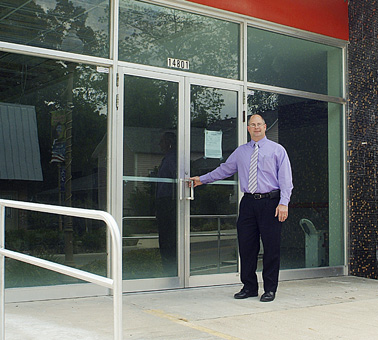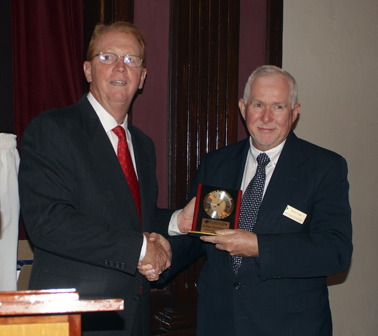 Incoming Alachua Chamber of Commerce President David Flinchum is excited about the opportunities ahead as the organization completes construction of its new offices on Alachua's Main Street.
Incoming Alachua Chamber of Commerce President David Flinchum is excited about the opportunities ahead as the organization completes construction of its new offices on Alachua's Main Street.
ALACHUA – The new president of the Alachua Chamber of Commerce has high hopes for the next 12 months.
David Flinchum, 41, manager of the Alachua Walgreens, became the new chamber president Tuesday night at the chamber’s annual banquet. Flinchum, who served as vice president since May of last year, has been in line to assume the position once David Pope, the former chamber president, finished his term.
Flinchum doesn't expect much to change. “I’m not trying to reinvent the wheel,” he said.
He said he plans to continue Pope’s initiatives, which aimed to give the chamber’s member businesses more value for their membership dues.
“My hope as the president of the chamber is to involve the members, the businesses, to support them and help them get business.” By doing that, more businesses will join the chamber, allowing the organization to offer additional support through the increased revenue in membership dues, he said. During Pope’s term, the chamber held mixers to facilitate networking between businesses. Flinchum said he wants to expand on that by offering services to match businesses with each other. For instance, if Walgreens needs a fence built around its property, they would know who in the chamber to contact.
During Flinchum’s term, the chamber will finally have a permanent home. Currently, it operates out of a small office at Alachua Elementary School. For the past several years, there have been plans to convert the building at 14801 Main Street into the chamber’s headquarters and welcome center. The building, formerly a post office, and more recently a police station, required a number of repairs. One of the chamber's biggest challenges has been getting the funding to make the site usable, Flinchum said.
“It needed, basically, to be gutted and rebuilt,” he said. It also needed to be brought up to code.
The new location is set to open around the October timeframe. Flinchum credits Pope with finally getting the new location in order. In addition to serving as the Alachua Chamber of Commerce’s office building, it will also be a welcome center for the community.
“We envision it as a place where people who are visiting can stop in and learn about the local community,” Flinchum said. There will be information available from the Alachua Historical Society about the area’s history, as well as details about local businesses.
The Alachua Chamber of Commerce sponsors and participates in local events including the annual Christmas parade, Main Street’s Scarecrow Row and Shop-Dine-Stroll on Main Street.
“Some people live here and don't know what is going on,” Flinchum said.
Flinchum was born and raised in Gainesville and moved to Alachua in 2003. Since then, he said he’s gotten involved with the local community, making him happy to serve it through the chamber. However, he said there probably won’t be any major changes during his term.
“There’s not a whole lot that's wrong,” he said.
# # #
Email CMcKinney@
alachuatoday.com
Add a comment

 Alachua and High Springs were represented by 16 teams in this year’s Relay for Life which took place at the High Springs Civic Center over an 18-hour period.
Alachua and High Springs were represented by 16 teams in this year’s Relay for Life which took place at the High Springs Civic Center over an 18-hour period.